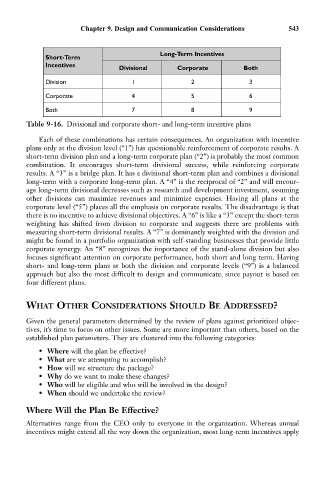Page 557 - Bruce Ellig - The Complete Guide to Executive Compensation (2007)
P. 557
Chapter 9. Design and Communication Considerations 543
Long-Term Incentives
Short-Term
Incentives
Divisional Corporate Both
Division 1 2 3
Corporate 4 5 6
Both 7 8 9
Table 9-16. Divisional and corporate short- and long-term incentive plans
Each of these combinations has certain consequences. An organization with incentive
plans only at the division level (“1”) has questionable reinforcement of corporate results. A
short-term division plan and a long-term corporate plan (“2”) is probably the most common
combination. It encourages short-term divisional success, while reinforcing corporate
results. A “3” is a bridge plan. It has a divisional short-term plan and combines a divisional
long-term with a corporate long-term plan. A “4” is the reciprocal of “2” and will encour-
age long-term divisional decreases such as research and development investment, assuming
other divisions can maximize revenues and minimize expenses. Having all plans at the
corporate level (“5”) places all the emphasis on corporate results. The disadvantage is that
there is no incentive to achieve divisional objectives. A “6” is like a “3” except the short-term
weighting has shifted from division to corporate and suggests there are problems with
measuring short-term divisional results. A “7” is dominantly weighted with the division and
might be found in a portfolio organization with self-standing businesses that provide little
corporate synergy. An “8” recognizes the importance of the stand-alone division but also
focuses significant attention on corporate performance, both short and long term. Having
short- and long-term plans at both the division and corporate levels (“9”) is a balanced
approach but also the most difficult to design and communicate, since payout is based on
four different plans.
WHAT OTHER CONSIDERATIONS SHOULD BE ADDRESSED?
Given the general parameters determined by the review of plans against prioritized objec-
tives, it’s time to focus on other issues. Some are more important than others, based on the
established plan parameters. They are clustered into the following categories:
• Where will the plan be effective?
• What are we attempting to accomplish?
• How will we structure the package?
• Why do we want to make these changes?
• Who will be eligible and who will be involved in the design?
• When should we undertake the review?
Where Will the Plan Be Effective?
Alternatives range from the CEO only to everyone in the organization. Whereas annual
incentives might extend all the way down the organization, most long-term incentives apply

